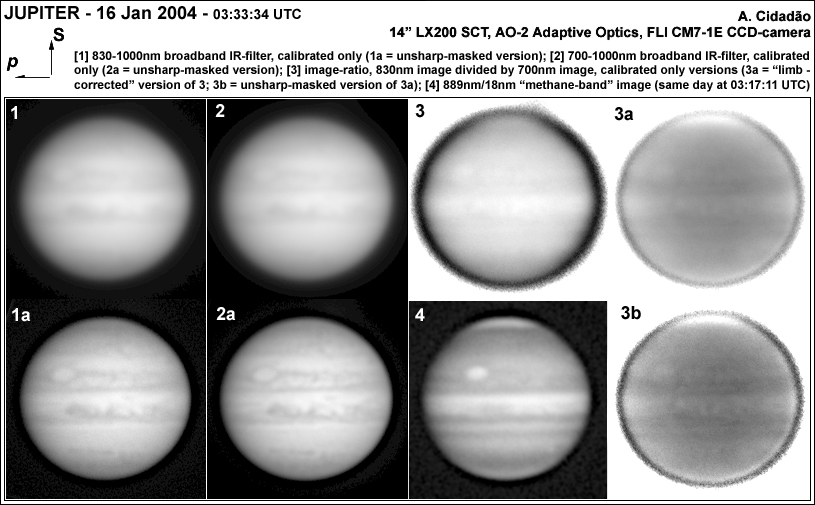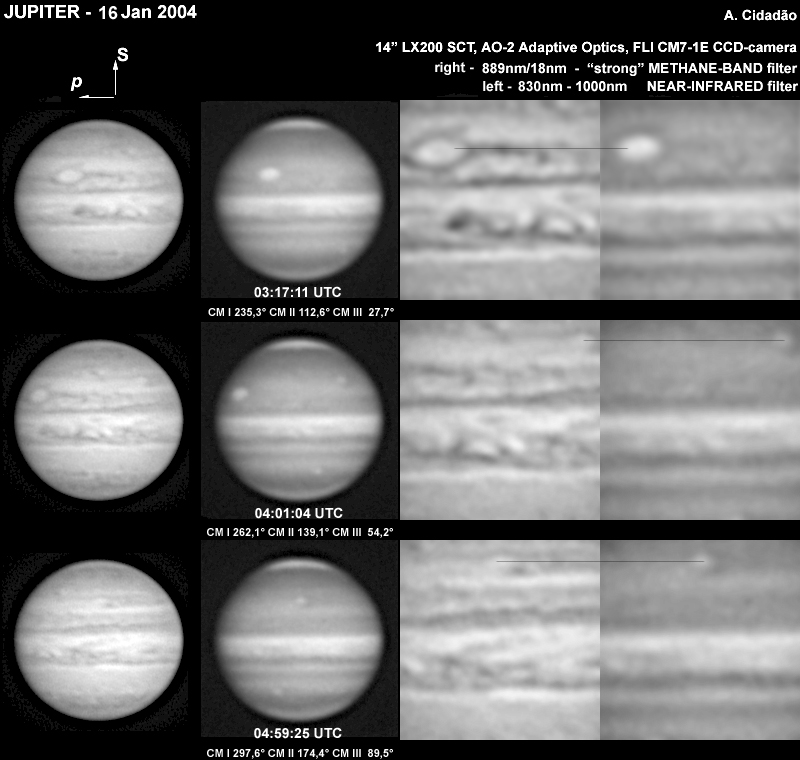|
Antonio Cidadao (250mm LX200SCT : FLICM7 1E CCD camera)
|

Hi all,
As a control of the image-ratios that I have been producing between two
"strong" methane-band filters (889nm CW; 5nm and 18nm FWHM), and following
some preliminary data I have already mentioned briefly, I'm now sending a
plate depicting the results that can be obtained on Jupiter by dividing two
broadband IR-filtered images (specifically, with the transmitances between
700nm-1000nm and a 830nm-1000nm).
As you may recall, to avoid planet rotation artefacts between the images
than had to be diveded one by the other, and since that integration times
may be considerably long, I have been producing "symetric" image series
containing data obtained with alternating filters. After averaging all the
frames produced by a given filter, two final images were produced, each for
each filter, and that could be ascribed the same time. Since methane images
have a low intrinsec contrast with respect to small scale features, I now
used two IR filters, using the same approach, to produce image ratios. Any
minor problem with image registration or distortion between final images
will surely produced an "emboss-like" artefact in image-ratios. As expected
this did not occur and, confirming earlier preliminary results, there is
some interesting use for such "ratio" images.
Specifically, a series of 9 images was obtained, where filters (parfocal)
were changed very quickly with a motorized wheel. The integration time was
always the same (for your info, the 700nm filter produced about 6-fold more
signal than the 830nm filter), and the sequence of images to be avereged for
each filter was the following:
830-700-830-700-830-700-830-700-830
"Time" ascribed for the two final images was mid exposure of the 5th image.
Image-ratios were (and should be) performed in calibrated (that is
preprocessed) images ONLY. In this case, the 830nm image was divided by the
700nm image.
Although the appearance of the preprocessed (and also of similarly
unsharp-masked) images obtained by both filters was "identical", image
ratios do reveal real differences (that is not related with eventual
problems of bad registering or distortion). These differences are a bit
better visualized when limb-darkening is corrected (as described in my
webpage), but already obvious in the plain ratio images.
Specifically, there is diferent limb darkening between filters, and albedo
differences for the same features. With the ratio used (830nm divided bt the
700nm) the polar hoods and EZ are brighter and, interestingly, the NTB while
invisible in each of the IR images is very obvious in their image-ratio.
Thus, the "ratio" appearance is generally similar to a methane-band image
(also shown for comparison), even in the latitude span of the methane-bright
EZ. Nevertheless, there are major differences in small-scale clouds, namely
in SEB.
What I would like to stress is that, although the "ratio" image between
these two broadband IR filters is not equivalent to a true methane-band
image, considering the sensitivity of our CCD cameras (decreases in near-IR
until almost zero at 1000nm) and the positioning of the strong methane
absorption band (at 889nm), the emerging pattern on "ratios" makes sense.
The other thing I would like to emphasize is related to the fact that much
more people have the posibility to do broadband IR imaging than methane
imaging, and the present demonstration that IR "ratios" can vring up and
allow us to follow features invisible when both filters are used
individually. The NTB, and also the brighter polar hoods and EZ are good
examples, but currently I would place the NTB as the most interesting
feature to approach this way.
Finaly, as expected, no "emboss-like" artefactual marks due to planet
rotation or bad registering were found...
Good observations
Antonio
-----------------------------------------
 Hi again,
Here is the Jan16 methane-broadbandIR colocalization survey, depicting the
longitudes following the GRS. Besides the already mentioned aspects, there
are no visible high altitude small and methane-bright clouds following the
GRS similar to those captured last apparition. At these longitudes ther is a
fair coincidence between IR bright and moderately methane bright features in
SEB.
Good observations
-----------------------------------------
Hi again,
Here is the Jan16 methane-broadbandIR colocalization survey, depicting the
longitudes following the GRS. Besides the already mentioned aspects, there
are no visible high altitude small and methane-bright clouds following the
GRS similar to those captured last apparition. At these longitudes ther is a
fair coincidence between IR bright and moderately methane bright features in
SEB.
Good observations
-----------------------------------------
 Hi all,
Here is Jan16 data regarding image ratios berween the two methane filters.
Some notes are included in the image itself
Steady skies
Antonio
≪アントニオ シダダオ ポルトガル≫
[Antonio Cidadao Oeiras - Portugal]
Hi all,
Here is Jan16 data regarding image ratios berween the two methane filters.
Some notes are included in the image itself
Steady skies
Antonio
≪アントニオ シダダオ ポルトガル≫
[Antonio Cidadao Oeiras - Portugal]
 ALPO-Japan Latest ALPO-Japan Latest

 Jupiter Section Jupiter Section
|

Hi again, Here is the Jan16 methane-broadbandIR colocalization survey, depicting the longitudes following the GRS. Besides the already mentioned aspects, there are no visible high altitude small and methane-bright clouds following the GRS similar to those captured last apparition. At these longitudes ther is a fair coincidence between IR bright and moderately methane bright features in SEB. Good observations -----------------------------------------
Hi all, Here is Jan16 data regarding image ratios berween the two methane filters. Some notes are included in the image itself Steady skies Antonio ≪アントニオ シダダオ ポルトガル≫ [Antonio Cidadao Oeiras - Portugal]
 ALPO-Japan Latest
ALPO-Japan Latest

 Jupiter Section
Jupiter Section